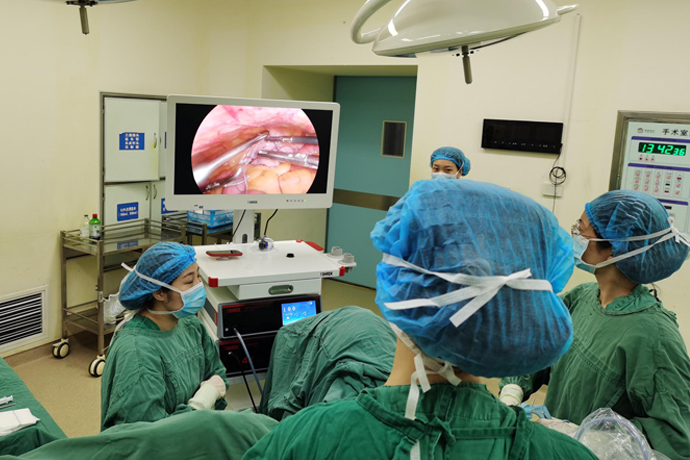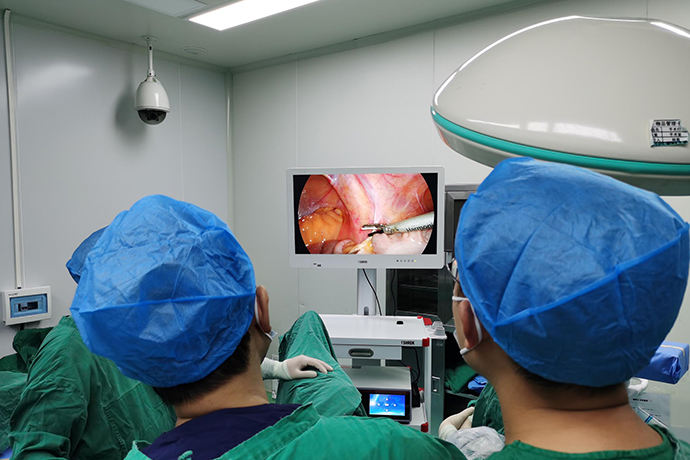【Laparoscopy】Exploratory laparoscopy
Release time: 03 Sep 2024 Author:Shrek
When it is difficult to diagnose through laboratory examinations and various imaging diagnostic techniques, laparoscopy has shown its unique and accurate diagnostic role, which can make up for the shortcomings of laboratory examinations and imaging examinations. Laparoscopic exploration has fewer complications and less pain. It not only allows direct observation of normal organs and diseased tissues, but also enables biopsy under direct vision, obtaining evidence of pathological examination, and accurate assessment by surgeons. It can also assist in treatment. If the lesion is confirmed to be the latter, surgical treatment can be performed immediately. Most of them replace the previous exploratory laparotomy and try to avoid blind laparotomy. In terms of diagnosis, it is used in the diagnosis of abdominal trauma, hepatitis, tuberculosis, ascites, abdominal masses, abdominal metastasis cancer, and liver cancer. For tumor staging, accurate preoperative laparoscopic staging of intra-abdominal malignant tumors can avoid unnecessary exploratory laparotomy.

Laparoscopic surgery is what we often call "punch" surgery. In fact, laparoscopy is not only used for surgery. Laparoscopy has the following three characteristics in the field of surgery: it can be used for diagnosis and treatment, and it is also minimally invasive. Laparoscopy is almost omnipresent, and more than 95% of operations on various organs in the abdomen and pelvis can be completed under laparoscopy. Laparoscopy extends the surgeon's line of sight into the abdominal cavity without opening the abdominal cavity. Laparoscopy can clearly magnify various organs in the abdominal cavity, and various lesions occurring on their surfaces can be clearly seen, and the results can be saved on the computer. image.
Why perform laparoscopy? Cause
Laparoscopy can make up for the shortcomings of traditional imaging examinations and provide reliable basis for further clarifying clinical diagnosis. In terms of diagnosis of many difficult and complicated diseases in abdominal surgery, such as unknown acute and chronic abdominal pain, the diagnostic accuracy of laparoscopy is much higher. Use B-ultrasound and CT to avoid delays caused by unclear diagnosis. Not only that, once the diagnosis of diagnostic laparoscopy is clear, most diseases can be cured directly under laparoscopy. More importantly, it is a minimally invasive surgery, causing only slight trauma to the patient.
General diagnostic laparoscopy
Indications
Diagnosis of acute and chronic abdominal pain of unknown origin.
Exploration of abdominal injuries.
Staging of abdominal malignant tumors.
Biopsy and differential diagnosis of liver disease.
Differential diagnosis of ascites.
Diagnosis of gynecological infertility.
Contraindications
Severe cardiopulmonary dysfunction.
Hemodynamic instability.
Difficult to correct coagulopathy.
Severe functional impairment or large amounts of ascites.
Severe intra-abdominal wall and intra-abdominal infection.
After multiple abdominal surgeries, it is estimated that there are extensive adhesions in the abdominal cavity.
Large hiatal hernia.
Rupture of diaphragm.
Mechanical or paralytic ileus.
Laparoscopic diagnosis of non-traumatic acute abdomen
Indications
unexplained acute abdomen.
Acute nonspecific abdominal pain (NSAP).
Those who have received diagnosis and symptoms, are not satisfied with the encouragement and Need further diagnosis.
Laparoscopic diagnosis of abdominal injuries
Indications
Small open abdominal wounds.
Patients with simple closed abdominal trauma, suspected of substantial organ rupture but no obvious hemorrhagic shock.
Patients with simple closed abdominal trauma, with signs of peritonitis, stable vital signs, and suspected cavity organ rupture.
Changes in condition cannot be explained by injuries to other parts of the body, and injuries to abdominal organs are suspected.
For those with multiple compound injuries, it is necessary to remove the damage to the abdominal organs first and then deal with other injuries.
Contraindications
Patients with severe hemorrhagic shock, unstable vital signs or severe peritonitis who decide to undergo laparotomy after abdominal trauma.
Patients with open abdominal trauma with large abdominal wall defects.
Those with severe chest or brain injuries.
Superiority
The diagnosis can be made as quickly as possible and the negative laparotomy rate can be reduced.
It can integrate diagnosis and treatment and reduce the rate of therapeutic laparotomy.
Know how to choose the incision and surgical method for laparotomy.
limitation
Not suitable for all patients with abdominal trauma. For hemodynamic instability or signs of severe peritonitis, exploratory laparotomy is necessary.
In addition to the common complications of laparoscopy, there is a risk of tension pneumothorax in patients with suspected diaphragmatic injury.
Only indirect evidence is provided for retroperitoneal injury, such as retroperitoneal hematoma, pneumatosis, bile staining, etc., and it cannot accurately provide injured organs and locations (such as duodenal injury, ureteral injury, kidney injury, etc.).
Less sensitive to small perforations of intra-abdominal hollow organs. Therefore, the exploration of the abdominal cavity during laparoscopy must be comprehensive and detailed and performed in sequence.
Frequently Asked Questions and Responses to Laparoscopic Exploration
(1) Master the indications. Abdominal pain recurs for more than half a year. Conservative treatment has no obvious effect. Multiple examinations cannot confirm the diagnosis. Abdominal signs are relatively mild when abdominal pain attacks. The location of abdominal pain is relatively fixed. There is a history of surgery in the past.
(2) Laparoscopy has a certain negative detection rate, and detailed communication must be conducted with the patient and family before the examination.
(3) Laparoscopy is helpful for observing the surface of organs, but it is difficult to observe the inside of solid organs, retroperitoneum, mucosa, bile duct, and ureteral cavity. Therefore, corresponding examinations must be done before surgery to rule out
(4) Don’t be satisfied with finding just one lesion during exploration. A comprehensive exploration of the abdominal cavity should be conducted to prevent other lesions from being missed.
(5) Female patients should ask a gynecologist for intraoperative consultation
Laparoscopic exploration precautions
Hemorrhage
After draining the accumulated blood and flushing the peritoneal cavity, look for bleeding lesions.
(1). Ectopic pregnancy
Bleeding characteristics: more pelvic blood accumulation.
Treatment: fallopian tube removal?
What is the difference between pelvic cavity and abdominal cavity?
(2). Liver and spleen damage
Characteristics: There is a lot of blood in the abdominal cavity
Treatment: ① Subcapsular hemorrhage, minor hepatic parenchymal rupture and bleeding: laparoscopic repair
②Severe liver parenchyma rupture and bleeding, or accompanied by bile leakage: transfer to laparotomy
③Splenic rupture and bleeding: Depending on the degree of rupture, the spleen should be preserved or removed.
Inflammatory exudate (pus), perforated ulcer (gastrointestinal contents)
Search for the primary lesion after peritoneal washing.
Common primary lesions are: gastroduodenal ulcer perforation, acute appendicitis, acute cholecystitis, acute pelvic inflammatory disease [requires surgery?]
Treatment: Deal with it accordingly, details omitted.
Adhesions
It indicates a history of previous surgery and peritonitis. [Why do intestinal adhesions occur after surgery? ]
Treatment: Adhesiolysis.
Nodules
Nodules can be found in: liver, peritoneum, pelvis
Treatment: Combined with laparoscopic ultrasound for diagnosis and staging, the patient will be treated accordingly.

- Recommended news
- 【General Surgery Laparoscopy】Cholecystectomy
- Surgery Steps of Hysteroscopy for Intrauterine Adhesion
- 【4K Basics】4K Ultra HD Endoscope Camera System
- 【General Surgery Laparoscopy】"Two-step stratified method" operation flow of left lateral hepatic lobectomy
- 【General Surgery Laparoscopy】Left Hepatectomy